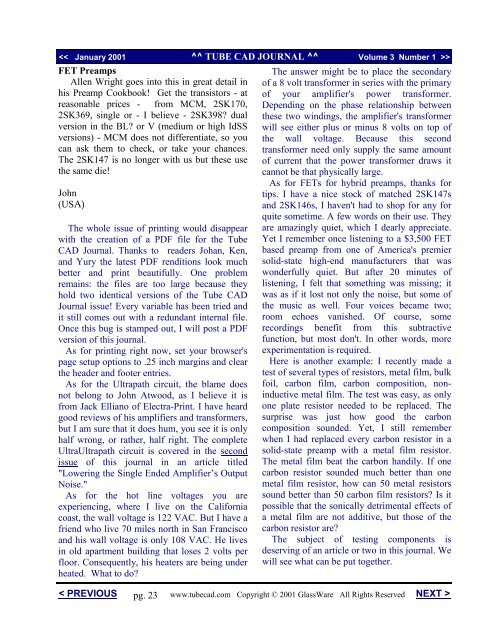Inverted Shunt Regulator - Tube CAD Journal
Inverted Shunt Regulator - Tube CAD Journal
Inverted Shunt Regulator - Tube CAD Journal
You also want an ePaper? Increase the reach of your titles
YUMPU automatically turns print PDFs into web optimized ePapers that Google loves.
FET Preamps<br />
Allen Wright goes into this in great detail in<br />
his Preamp Cookbook! Get the transistors - at<br />
reasonable prices - from MCM, 2SK170,<br />
2SK369, single or - I believe - 2SK398? dual<br />
version in the BL? or V (medium or high IdSS<br />
versions) - MCM does not differentiate, so you<br />
can ask them to check, or take your chances.<br />
The 2SK147 is no longer with us but these use<br />
the same die!<br />
John<br />
(USA)<br />
The whole issue of printing would disappear<br />
with the creation of a PDF file for the <strong>Tube</strong><br />
<strong>CAD</strong> <strong>Journal</strong>. Thanks to readers Johan, Ken,<br />
and Yury the latest PDF renditions look much<br />
better and print beautifully. One problem<br />
remains: the files are too large because they<br />
hold two identical versions of the <strong>Tube</strong> <strong>CAD</strong><br />
<strong>Journal</strong> issue! Every variable has been tried and<br />
it still comes out with a redundant internal file.<br />
Once this bug is stamped out, I will post a PDF<br />
version of this journal.<br />
As for printing right now, set your browser's<br />
page setup options to .25 inch margins and clear<br />
the header and footer entries.<br />
As for the Ultrapath circuit, the blame does<br />
not belong to John Atwood, as I believe it is<br />
from Jack Elliano of Electra-Print. I have heard<br />
good reviews of his amplifiers and transformers,<br />
but I am sure that it does hum, you see it is only<br />
half wrong, or rather, half right. The complete<br />
UltraUltrapath circuit is covered in the second<br />
issue of this journal in an article titled<br />
"Lowering the Single Ended Amplifier’s Output<br />
Noise."<br />
As for the hot line voltages you are<br />
experiencing, where I live on the California<br />
coast, the wall voltage is 122 VAC. But I have a<br />
friend who live 70 miles north in San Francisco<br />
and his wall voltage is only 108 VAC. He lives<br />
in old apartment building that loses 2 volts per<br />
floor. Consequently, his heaters are being under<br />
heated. What to do?<br />
< PREVIOUS<br />
pg. 23<br />
The answer might be to place the secondary<br />
of a 8 volt transformer in series with the primary<br />
of your amplifier's power transformer.<br />
Depending on the phase relationship between<br />
these two windings, the amplifier's transformer<br />
will see either plus or minus 8 volts on top of<br />
the wall voltage. Because this second<br />
transformer need only supply the same amount<br />
of current that the power transformer draws it<br />
cannot be that physically large.<br />
As for FETs for hybrid preamps, thanks for<br />
tips. I have a nice stock of matched 2SK147s<br />
and 2SK146s, I haven't had to shop for any for<br />
quite sometime. A few words on their use. They<br />
are amazingly quiet, which I dearly appreciate.<br />
Yet I remember once listening to a $3,500 FET<br />
based preamp from one of America's premier<br />
solid-state high-end manufacturers that was<br />
wonderfully quiet. But after 20 minutes of<br />
listening, I felt that something was missing; it<br />
was as if it lost not only the noise, but some of<br />
the music as well. Four voices became two;<br />
room echoes vanished. Of course, some<br />
recordings benefit from this subtractive<br />
function, but most don't. In other words, more<br />
experimentation is required.<br />
Here is another example: I recently made a<br />
test of several types of resistors, metal film, bulk<br />
foil, carbon film, carbon composition, noninductive<br />
metal film. The test was easy, as only<br />
one plate resistor needed to be replaced. The<br />
surprise was just how good the carbon<br />
composition sounded. Yet, I still remember<br />
when I had replaced every carbon resistor in a<br />
solid-state preamp with a metal film resistor.<br />
The metal film beat the carbon handily. If one<br />
carbon resistor sounded much better than one<br />
metal film resistor, how can 50 metal resistors<br />
sound better than 50 carbon film resistors? Is it<br />
possible that the sonically detrimental effects of<br />
a metal film are not additive, but those of the<br />
carbon resistor are?<br />
The subject of testing components is<br />
deserving of an article or two in this journal. We<br />
will see what can be put together.<br />
www.tubecad.com Copyright © 2001 GlassWare All Rights Reserved NEXT >

















